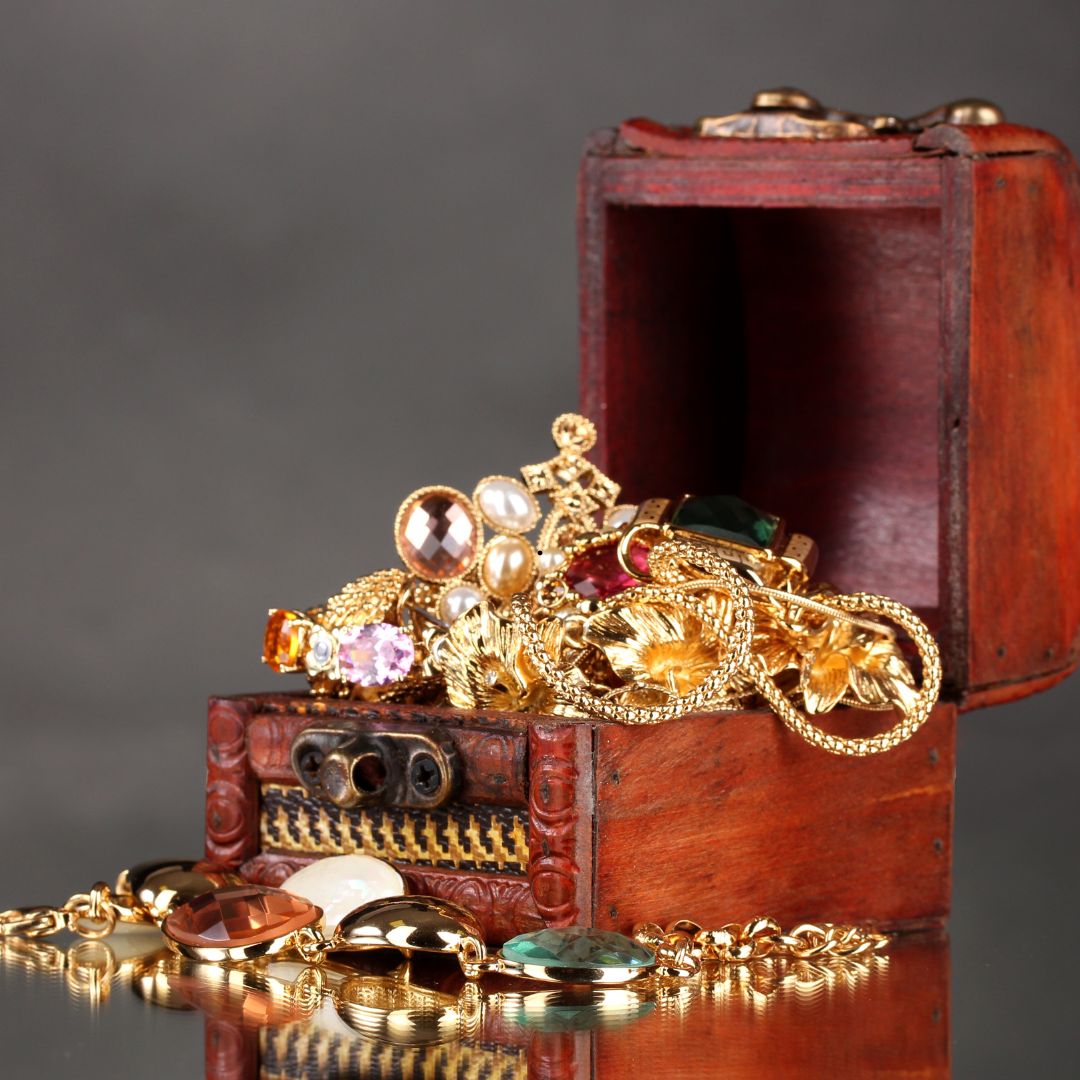
How to Store Your Gold Jewelry to Prevent Scratches and Tarnish
Published by Fiyonk Jewelry
Gold jewelry is more than just an accessory—it’s an investment, a statement, and often a cherished heirloom. For those who have a deep appreciation for gold or have invested significantly in these precious pieces, proper storage is critical to maintaining their brilliance and value. Scratches and tarnish can diminish the aesthetic appeal and even the financial worth of gold jewelry. In this comprehensive guide, we’ll explore expert strategies to store your gold jewelry effectively, ensuring it remains as radiant as the day you acquired it.
Understanding Gold and Its Vulnerabilities
Gold, revered for its lustrous beauty and enduring value, is a soft metal, particularly in higher karat forms like 18K or 24K. Its malleability makes it prone to scratches, dents, and abrasions when mishandled or improperly stored. Additionally, while pure gold does not tarnish, most gold jewelry is alloyed with other metals like copper or silver to enhance durability. These alloys can react with environmental factors such as humidity, air pollutants, or chemicals, leading to tarnish or discoloration.
For avid collectors and investors, preserving the pristine condition of gold jewelry is paramount. Whether your collection includes delicate chains, ornate rings, or statement necklaces, the following storage practices will help safeguard your treasures.
Key Principles for Storing Gold Jewelry
1. Store Each Piece Individually
One of the most effective ways to prevent scratches is to ensure that gold jewelry pieces do not come into contact with one another. When multiple items are stored together, they can rub against each other, causing micro-abrasions that dull the surface over time.
-
Use Soft Pouches or Cloth-Lined Boxes: Store each piece in its own soft, anti-tarnish cloth pouch or a small, lined jewelry box. Anti-tarnish fabrics, often infused with silver particles, absorb moisture and neutralize tarnish-causing chemicals.
-
Ziplock Bags for Extra Protection: For added security, place individual pouches in airtight ziplock bags to minimize exposure to air and humidity.
-
Compartmentalized Trays: For larger collections, invest in a jewelry box with velvet-lined compartments or dividers to keep each piece isolated.
2. Choose the Right Storage Environment
The environment in which you store your gold jewelry significantly impacts its longevity. Exposure to moisture, extreme temperatures, or pollutants can accelerate tarnishing and damage.
-
Control Humidity: Store jewelry in a cool, dry place with humidity levels below 50%. A climate-controlled room or a jewelry safe is ideal. Avoid bathrooms or basements, where humidity levels fluctuate.
-
Avoid Direct Sunlight: Prolonged exposure to sunlight can cause fading in gemstones often paired with gold and may weaken certain alloys. Opt for a shaded, enclosed storage area.
-
Use Silica Gel Packets: Place silica gel packets in your jewelry box or storage area to absorb excess moisture, reducing the risk of tarnish.
3. Clean Before Storing
Never store gold jewelry without cleaning it first. Oils from your skin, perfumes, lotions, and environmental debris can cling to the surface, promoting tarnish or corrosion over time.
-
Gentle Cleaning Method: Use a mild dish soap mixed with warm water and a soft toothbrush to gently clean your jewelry. Rinse thoroughly and dry with a lint-free microfiber cloth.
-
Avoid Harsh Chemicals: Steer clear of abrasive cleaners or solutions containing ammonia, bleach, or acids, as they can damage gold alloys or gemstones.
-
Polish Sparingly: While polishing can restore shine, overuse can wear down the gold’s surface. Use a polishing cloth designed for gold jewelry and follow the grain of the metal.
4. Protect Against Physical Damage
Gold’s softness makes it susceptible to scratches and dents, especially for high-karat pieces or those with intricate designs. Proper storage minimizes physical damage.
-
Avoid Stacking: Never stack jewelry in a single container, as heavier pieces can press against lighter ones, causing scratches or deformation.
-
Use Anti-Slip Mats: For drawers or trays, line surfaces with anti-slip velvet or felt mats to prevent pieces from sliding and bumping into each other.
-
Secure Clasps and Settings: Ensure clasps are closed and prongs holding gemstones are secure before storing to prevent snagging or loosening.
5. Invest in Anti-Tarnish Solutions
For those who have invested heavily in gold, incorporating anti-tarnish technology into your storage routine is a wise choice.
-
Anti-Tarnish Strips: Place anti-tarnish strips or tabs in your jewelry box. These products absorb sulfur and other tarnish-causing compounds from the air.
-
Activated Charcoal: Some collectors use activated charcoal packets to neutralize odors and chemicals that contribute to tarnishing.
-
Professional Storage Cases: Consider investing in a high-quality jewelry safe with built-in anti-tarnish linings and climate control for high-value collections.
6. Special Considerations for Gold with Gemstones
Many gold jewelry pieces feature gemstones, which require additional care to maintain their sparkle and integrity.
-
Check Hardness: Gemstones like diamonds (Mohs scale 10) are durable, but softer stones like opals (Mohs scale 5.5–6.5) or pearls (Mohs scale 2.5–4.5) are prone to scratching. Store these pieces separately to avoid contact with harder materials.
-
Avoid Chemical Exposure: Certain gemstones, such as emeralds or turquoise, are sensitive to chemicals. Ensure they are cleaned and stored away from perfumes or cleaning agents.
-
Use Padded Containers: Store gemstone-set gold jewelry in padded cases to cushion delicate stones and prevent chipping.
7. Organize for Accessibility
For collectors with extensive gold jewelry collections, organization is key to both protection and convenience.
-
Label Storage: Label pouches or compartments to quickly locate specific pieces without rummaging, which can cause accidental damage.
-
Rotate Wear: Regularly rotate the pieces you wear to prevent any single item from sitting in storage for too long, as prolonged inactivity can expose jewelry to dust and moisture buildup.
-
Inventory Your Collection: Maintain a detailed inventory with photos and descriptions of each piece. This not only aids in organization but also serves as documentation for insurance purposes.
8. Insurance and Security for High-Value Pieces
For those who have invested significantly in gold, protecting your collection extends beyond physical care to financial security.
-
Jewelry Insurance: Obtain a specialized jewelry insurance policy to cover loss, theft, or damage. Ensure your policy includes coverage for scratches or tarnish-related repairs.
-
Safe Storage: For high-value items, consider a fireproof and waterproof safe with a combination or biometric lock. Ensure the safe is bolted to the floor for added security.
-
Regular Appraisals: Have your gold jewelry appraised every few years to reflect current market values, especially for investment-grade pieces.
Common Mistakes to Avoid
Even seasoned gold enthusiasts can make storage mistakes that jeopardize their collection. Here are pitfalls to avoid:
-
Storing in Plastic Containers Without Linings: Hard plastic can scratch gold. Always use soft, lined containers.
-
Using Tissue Paper or Cotton: These materials can trap moisture or leave fibers on jewelry, promoting tarnish or scratches.
-
Neglecting Regular Inspections: Check your stored jewelry periodically for signs of tarnish, loose stones, or damage to address issues early.
-
Overcrowding Storage: Overfilled jewelry boxes increase the risk of scratches and tangling. Ensure ample space for each piece.
Maintaining Your Investment
For those who view gold jewelry as both a passion and an investment, proper storage is non-negotiable. Gold prices fluctuate, but well-maintained pieces retain their value and appeal. By following these expert tips—storing individually, controlling the environment, cleaning properly, and using anti-tarnish solutions—you can ensure your gold jewelry remains a source of pride and beauty for years to come.
At Fiyonk Jewelry, we understand the deep connection collectors and investors feel toward their gold pieces. Our commitment to craftsmanship extends to helping you preserve the brilliance of your collection. Whether you’re a seasoned investor or a passionate enthusiast, these storage practices will protect your gold jewelry from scratches and tarnish, ensuring it shines as brightly as your appreciation for it.
FAQs
1. Can I store gold jewelry with other precious metals like silver or platinum?
It’s best to avoid storing gold jewelry with other metals, such as silver or platinum, as they have different hardness levels. Platinum is harder and can scratch softer gold, while silver may release sulfur compounds that accelerate tarnishing in gold alloys. Use separate pouches or compartments for each metal type.
2. How often should I check my stored gold jewelry for maintenance?
Inspect your gold jewelry every three to six months, even when stored properly. Look for signs of dust accumulation, loose clasps, or early tarnish on alloyed pieces. Regular checks allow you to address issues promptly and maintain your collection’s condition.
3. Is it safe to store gold jewelry in a bank safety deposit box?
Yes, a bank safety deposit box is secure for high-value gold jewelry, but ensure the box has a low-humidity environment. Wrap each piece in anti-tarnish cloth and place it in an airtight container to protect against moisture or air exposure, as bank vaults may not always be climate-controlled.
4. Can I use cotton-lined jewelry boxes instead of velvet or felt?
Cotton linings are not ideal, as they can retain moisture and may contain fibers that cling to jewelry, potentially causing micro-scratches. Velvet or felt-lined boxes are preferable, as they are softer and less likely to trap moisture, offering better protection for gold.
5. How do I store gold jewelry when traveling?
When traveling, use a travel jewelry case with padded, individual compartments or soft pouches for each piece. Avoid tossing jewelry into a bag or suitcase, as movement can cause scratches. Include a small silica gel packet in the case to control moisture during transit.
6. Should I remove gold jewelry before storing it in a humid climate?
In humid climates, always clean and thoroughly dry your gold jewelry before storage to prevent moisture-related tarnish. Consider using a dehumidifier in your storage area or sealed containers with desiccant packets to maintain a dry environment.
7. Can I store gold jewelry near electronics or magnetic devices?
Avoid storing gold jewelry near electronics or magnetic devices, as electromagnetic fields may affect certain gemstones or delicate settings in gold pieces. While gold itself is non-magnetic, prolonged exposure could loosen settings or impact gemstone clarity in rare cases.
8. What should I do if I notice early signs of tarnish on my gold jewelry?
If you spot early tarnish, gently clean the piece with a solution of lukewarm water and a drop of mild dish soap using a soft cloth. Rinse and dry thoroughly. For persistent tarnish, consult a professional jeweler to avoid damaging the gold or any gemstones.
9. Are there specific storage considerations for gold-plated jewelry?
Gold-plated jewelry is more prone to wear, as the gold layer is thin. Store it separately from solid gold to prevent abrasion, and use anti-tarnish strips, as the base metals in gold-plated pieces are more susceptible to tarnishing than higher-karat gold.
10. How can I safely store antique or vintage gold jewelry?
Antique or vintage gold jewelry often has delicate craftsmanship or patina that requires extra care. Store these pieces in acid-free, anti-tarnish pouches or boxes, and avoid over-cleaning to preserve their historical finish. Consult a professional conservator for valuable or fragile heirlooms.
References
-
Gemological Institute of America (GIA). (2023). Caring for Your Jewelry. Retrieved from https://www.gia.edu/jewelry-care-maintenance
-
American Gem Society (AGS). (2024). How to Care for Your Gold and Gemstone Jewelry. Retrieved from https://www.americangemsociety.org/jewelry-care
-
Jewelers of America (JA). (2023). Jewelry Storage and Maintenance Guide. Retrieved from https://www.jewelers.org/education/jewelry-care
-
The Assay Office, London. (2022). Understanding Gold Alloys and Tarnish Prevention. Retrieved from https://www.assayofficelondon.co.uk/gold-care
-
Smithsonian Institution. (2021). Preserving Precious Metals in Collections. Retrieved from https://www.si.edu/mci/metal-care






